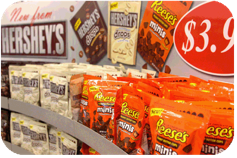 Though it might not seem like it to the casual snacker, packaging plays a big part in the way we eat. Food companies spend a fortune studying the psychology behind our eating habits in order to discover the most effective pathways into America’s stomachs. Surprisingly, they’ve found out that perhaps the best way to keep customers snacking is through resealable packages rather than individually wrapped ones. For example, research conducted by Hershey showed that individual wrappers on items like candy or granola bars prevented people from eating them in certain situations, such as in the car.
Though it might not seem like it to the casual snacker, packaging plays a big part in the way we eat. Food companies spend a fortune studying the psychology behind our eating habits in order to discover the most effective pathways into America’s stomachs. Surprisingly, they’ve found out that perhaps the best way to keep customers snacking is through resealable packages rather than individually wrapped ones. For example, research conducted by Hershey showed that individual wrappers on items like candy or granola bars prevented people from eating them in certain situations, such as in the car.
In response the company unveiled Reese’s Minis, a small version of the brand’s signature peanut butter cup in a resealable plastic bag. Placing unwrapped pieces of candy in this context encourages what industry executives have dubbed “hand-to-mouth” eating. In this sense, consumers can simply unzip the bag and grab a few treats, then close it back up until they get peckish again later. While this ultimately causes the consumer to eat less in one particular moment, over time they actually tend to eat more of the item. Part of this goes hand in hand with Americans’ near inability to judge portions. Since Reese’s Minis are less caloric than their larger forbearers, people who would fret over eating an entire candy bar in one sitting can sate their craving with just a few small pieces instead. All those isolated incidents add up, however, and soon that same seemingly health conscious person is eating more candy than ever.
This consistent consumption creates a relationship between the eater and the item, often leading them to purchase the small-portioned snacks along with their other groceries. Since many candy bars are purchased as impulse buys, the regular patronage brought on by savvier packaging is undoubtedly appealing to food companies. That’s why Hershey recently rolled out mini versions of Kit Kat, Rolo, Twizzlers, and even its chocolate bar. The trend isn’t limited to candy, though. Small “grab-and-go” packages of hummus made by the Sabra Dipping Company may have contributed to an overall increase in consumption of the Mediterranean staple.
Questions:
- What is one of the key marketing advantages of small-portioned snacks?
- What key factor are producers of small-portioned snacks relying on?
Source: Sarah Nassauer, “The Psychology of Small Packages,” The Wall Street Journal, April 16, 2013. Photo courtesy of Linda Sellers.
